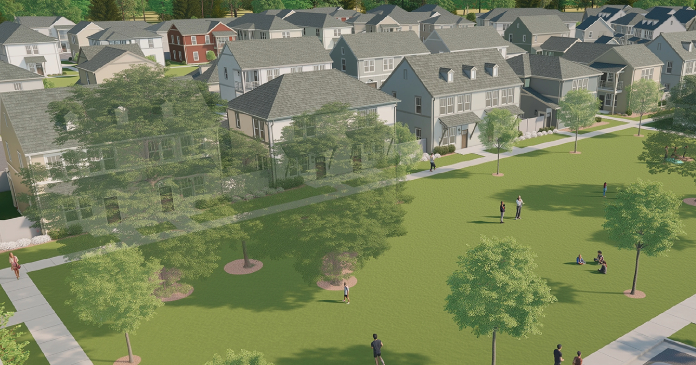CoStar reported that its value-weighted index of multifamily property prices fell 0.6 percent month-over-month in February, the second consecutive month-over-month loss. However, this index was up 2.2 percent year-over-year.
By contrast, MSCI Real Capital Analytics reported that multifamily property prices were up 0.2 percent for the month but down 1.3 percent year-over-year in February.
The value-weighted index of non-multifamily commercial property fell 1.0 percent month-over-month in February. This index is down 4.1 percent year-over-year. The other commercial property types tracked by CoStar are office, retail, industrial and hospitality.
For more information on the CoStar Commercial Repeat Sales Indexes (CCRSI’s), please see the description at the bottom of this report.
Multifamily property prices in upward trend
The first chart, below, shows the history of the value-weighted CCRSI’s since January 2016 for multifamily property and for all other commercial property considered as a single asset class. It also shows trend lines for the growth in the two CCRSI’s based on their growth in the period from January 2012 to January 2020. The indexes are normalized so that their values in December 2000 are set to 100.
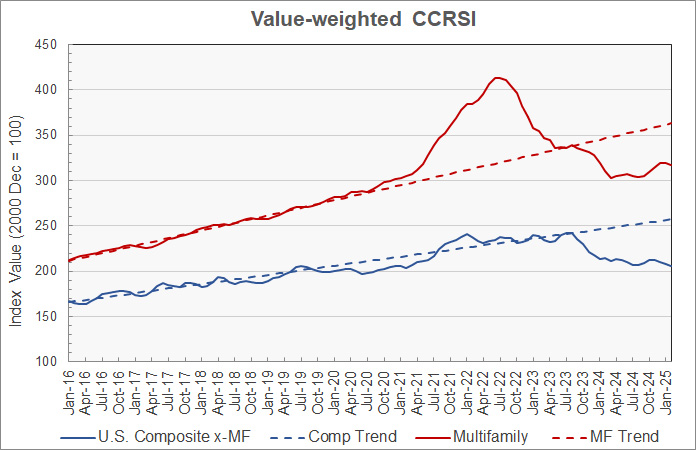 The chart shows that multifamily property prices were rising approaching the end of last year. However, multifamily property prices have been declining since then. Currently, multifamily property prices are down 23.3 percent from the high they reached in July 2022. They are 12.7 percent below their pre-pandemic trend.
The chart shows that multifamily property prices were rising approaching the end of last year. However, multifamily property prices have been declining since then. Currently, multifamily property prices are down 23.3 percent from the high they reached in July 2022. They are 12.7 percent below their pre-pandemic trend.
Prices for other commercial property types also fell again this month. They have been declining since reaching a recent high last October. These prices are now 15.2 percent below their all-time high and 20.0 percent below their pre-pandemic trend.
The second chart shows the recent history of multifamily property prices and other commercial property prices based on this month’s data along with the estimates from last month. For purposes of this chart, the price indexes for both property groupings were set to values of 100 in January 2020 so that the indexes could be plotted together at a scale that would show the detailed price movements.
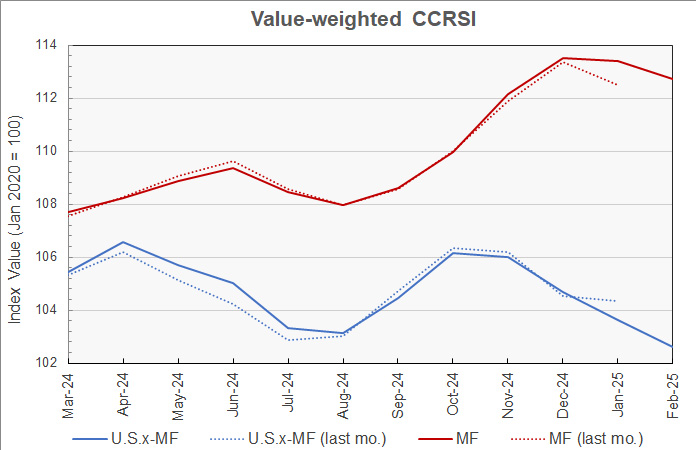
The chart shows that new transactions added to the data sets in February mitigated last month’s drop in multifamily property prices. However, it made last month’s drop in non-multifamily property prices larger than first estimated.
Transaction volumes continue decline
An issue with monthly transaction volume reporting is that CoStar usually identifies additional transactions to tabulate over the next few months after the initial report, and these extra transactions tend to make initial reports of falling transaction volumes appear more severe than they will subsequently appear. For example, CoStar reported that the transaction volume in February for all property types was down 284 transactions (20.5 percent) from the revised level of the month before, but it was down only 13.1 percent from the preliminary level for January reported last month.
CoStar reported that their initial transaction count for February was 1,101 repeat sales pairs. This is down from the 1,267 transaction pairs identified for January in last month’s report and down from the 1,385 transaction pairs identified for January in this month’s report. Meanwhile, the current transaction count of 2,040 for December is the highest transaction volume reported since June 2022.
The history of the revisions to the transaction counts for recent months is illustrated in the next chart. It shows that the number of transactions for September was initially given as 1,197 in the October report and has been revised in every subsequent report. While the size of the transaction count revision was largest in the next month’s report, additional transaction pairs for September continued to be identified in every subsequent report. The current report identifies 1,440 transactions for September. By contrast, transaction data for February only appears in the current (March) report, We can expect it to be revised next month.
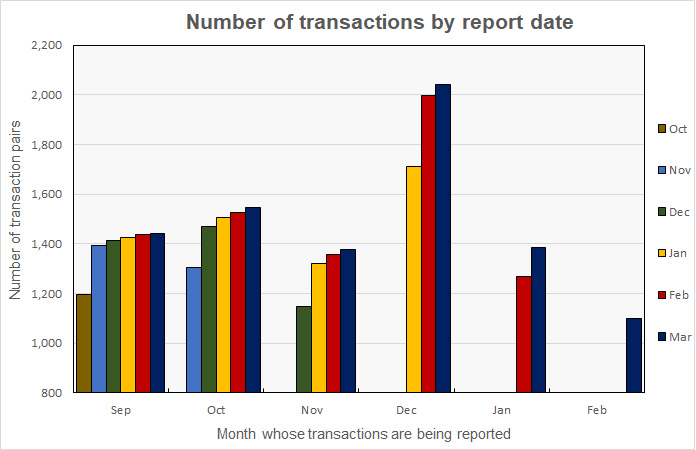
The preliminary dollar volume of transactions was reported to fall 19.9 percent from the revised level of the month before to $7.88 billion. The dollar volume of transactions fell 13.0 percent from the preliminary level reported last month.
Distress eases
CoStar also reported on the portion of sales that would be considered “distressed”. The next chart shows the distressed sales trends for all commercial property sales. Because of volatility in the data, the chart presents the 3-month weighted moving average of CoStar’s distressed sales data.
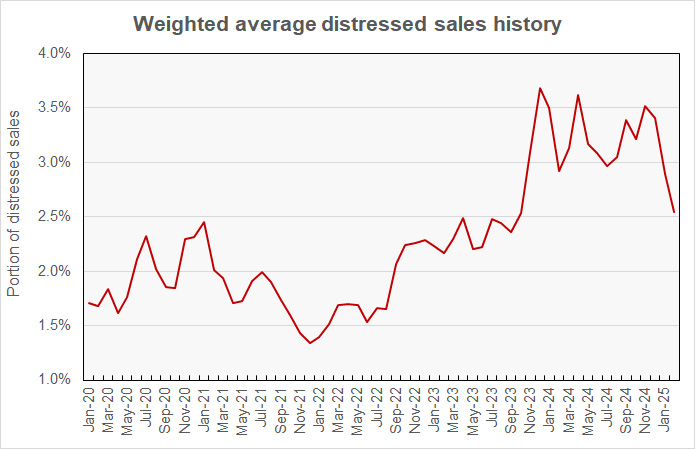
The chart shows that the portion of sales that CoStar designates as distressed remained at a high, if variable, level throughout 2024. However, early readings for 2025 show the level of distressed sales falling close to 2023 levels. Given the volatility of the data, it is not yet clear if this is a pattern or just two months of unusually low reports of distress.
The full report discusses all commercial property types. While the CoStar report provides information on transaction volumes, it does not break out multifamily transactions. The latest CoStar report can be found here.
CCRSI defined
The CoStar report focuses on a relative measure of property prices called the CoStar Commercial Repeat Sales Index (CCRSI). The index is computed based on the resale of properties whose earlier sales prices and sales dates are known. The index represents the relative change in the price of property over time rather than its absolute price. CoStar identified 1,101 repeat sale pairs in February for all property types. These sales pairs were used to calculate the results quoted here.
CoStar computes CCRSI’s for a variety of property groupings, combining them by cost, region, property type or other factors. The value-weighted index is more heavily influenced by transactions of expensive properties than is CoStar’s equal-weighted index. The value-weighted index is the focus of this report because it is an index whose value is reported monthly and for which CoStar breaks out multifamily property as a separate category.










